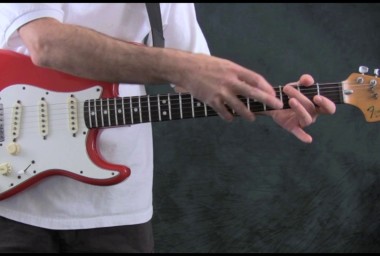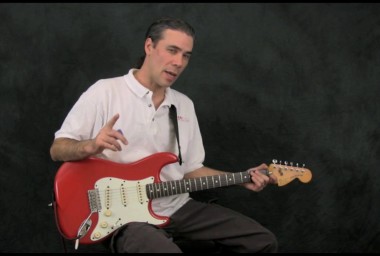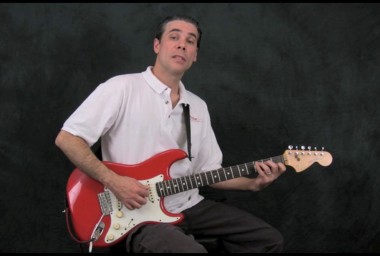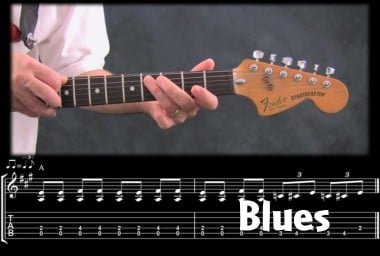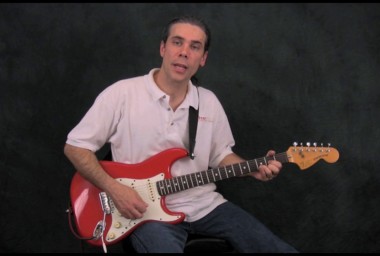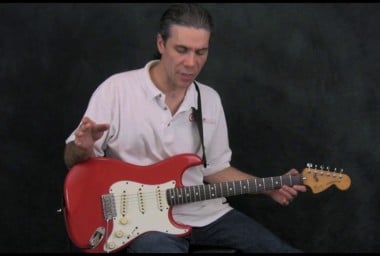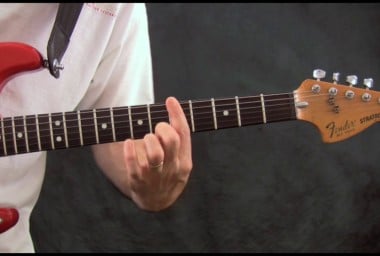Guitar Fundamentals 2 v1 (discontinued)
Chapter: 1: Introduction to Music Theory
What are intervals? This tutorial covers the basic concept of an interval as a musical distance and how to apply it on the guitar.
Published: 06/17/2007 UpgradeIn this tutorial we will learn more about picking and to play 3 basic picking techniques. These techniques are the foundation of most of the riffs and licks you'll learn. Every time you'll see someone using a pick, there's a good chance he'll be using one of the techniques we'll learn here.
Published: 06/25/2009 UpgradeThis tutorial explains the concept (theory) of the C Major Scale and how to apply it (practice) to the guitar. This tutorial is primarily written for beginners. But even experienced players might benefit from this quick, concise review of what constitues a scale.
Published: 06/17/2007 UpgradeIn this tutorial we will combine the C Major scale in two different positions with the proper picking techniques learned in the previous tutorial: <i>downstrokes, upstrokes, </i> and <i>alternate picking</i>. We will apply all three picking techniques to the C Major scale, and achieve a basic system of practicing scales for beginner guitarists.
Published: 06/25/2009 UpgradeThis tutorial explains the concept (theory) of the A Minor Scale and how to apply it (practice) to the guitar. This tutorial is primarily written for beginners. But even experienced players might benefit from this quick, concise review of what constitutes a scale.
Published: 12/06/2007 UpgradeIn this tutorial we will combine the A Minor scale in two different positions with the proper picking techniques learned in the previous tutorial: <i>downstrokes, upstrokes, </i> and <i>alternate picking</i>. We will apply all three picking techniques to the C Major scale, and achieve a basic system of practicing scales for beginner guitarists.
Published: 06/25/2009 UpgradeThis tutorial shows how to do basic scale exercises with the C Minor Scale. This tutorial is primarily written for beginners. But even experienced players might benefit from this quick, concise review of how to "practice scales".
Published: 12/06/2007 UpgradeChapter: 2: Introduction to Minor Chords
This tutorial introduces the beginning guitar player to the full (non-simplified) versions of the A, D and E minor chords in open position. These are the standard basic chords that form the basis for thousands of songs.
Published: 01/07/2008 UpgradePlaying chords is the first step in guitar playing. Switching between chords is the first great leap in guitar skill. If you can switch between chords, you can play a song. This tutorial for the beginning student introduces changing minor chords at a very slow pace.
Published: 01/07/2008 UpgradePlaying chords is the first step in guitar playing. Switching between chords is the first great leap in guitar skill. If you can switch between chords, you can play a song. This tutorial teaches the beginning student how to switch between G, E minor, C and D chords in time with a backing track.
Published: 01/08/2008 UpgradePlaying chords is the first step in guitar playing. Switching between chords is the first great leap in guitar skill. If you can switch between chords, you can play a song. This tutorial teaches the beginning student how to switch between C, A minor, F and G chords in time with a backing track.
Published: 01/08/2008 UpgradePlaying chords is the first step in guitar playing. Switching between chords is the first great leap in guitar skill. If you can switch between chords, you can play a song. This tutorial teaches the beginning student how to switch between A minor, C, D minor and E chords in time with a backing track.
Published: 01/08/2008 UpgradeOne of the most challenging tasks for a new guitarist can be making chord changes smoothly and quickly, without creating a pause in the music. Often times, coming up with a specific strategy for getting from one chord to the next can make all the difference. This tutorial presents four powerful tools for improving the speed of your chord changes.
Published: 02/24/2008 UpgradeChapter: 3: Scales and Chords and Triads
This tutorial explains how scales and chords are related to each other. You will also learn musical examples that show how to combine scales and chords.
Published: 11/21/2007 UpgradeThis tutorial shows you an exercise on how the A major scale can be used to "walk in and out" of a group of related major chords (A, D, E major).
Published: 11/21/2007 UpgradeThis tutorial shows you an exercise on how the A minor scale can be used to "walk in and out" of a group of related minor chords (A, D, E minor).
Published: 11/21/2007 UpgradeBy the end of this tutorial you should understand and be able to play basic triad chord shapes and their inversions in multiple fretboard locations. You should understand how chords are built from scales and the concept of triadic harmony or tertiary harmony.
Published: 09/15/2009 UpgradeChapter: 4: Introduction to Reading Music Notation
In this tutorial series we will learn the basic concepts of music notation & apply them to reading music for the guitar.
Published: 12/26/2006 UpgradeThis is Part 2 in a series of tutorials that are an absolute beginner's guide to reading music notation. In this tutorial series we will learn more concepts of music notation & apply them to reading music for the guitar. This series covers the topics: key signature, dynamics, phrasing.
Published: 03/12/2007 UpgradeThis single lesson tutorial provides a simple reference for reading music notation. This chart shows you rhythm symbols, the time duration, and how to count them.
Published: 01/27/2011 UpgradeChapter: 5: Simple Songs Using Chords and Scale Notes
Chapter: 6: Learn and Practice More Chord Groups
This tutorial introduces the beginning guitar player to the full (non-simplified) versions of the B, C, F and G minor chords. These are standard basic chords that form the basis for thousands of songs.
Published: 01/08/2008 UpgradeIn this tutorial series we will use a backing track to practice the chords A major, D major, and E major. We are going to focus on two things: getting from one chord shape to the next and doing it in time with the music.
Published: 12/20/2007 UpgradeIn this tutorial series we will use a backing track to practice the chords A minor, D minor, and E minor. We are going to focus on two things: getting from one chord shape to the next and doing it in time with the music.
Published: 12/20/2007 UpgradeIn this tutorial series we will use a backing track to practice the chords C major, F major, and G major. We are going to focus on two things: getting from one chord shape to the next and doing it in time with the music.
Published: 12/20/2007 UpgradeIn this tutorial series we will use a backing track to practice the chords C minor, F minor, and G minor. We are going to focus on two things: getting from one chord shape to the next and doing it in time with the music.
Published: 12/20/2007 UpgradeIn this tutorial series we will use a backing track to practice the chords E major, A major, and B major. We are going to focus on two things: getting from one chord shape to the next and doing it in time with the music.
Published: 12/20/2007 UpgradeIn this tutorial series we will use a backing track to practice the chords E minor, A minor, and B minor. We are going to focus on two things: getting from one chord shape to the next and doing it in time with the music.
Published: 12/20/2007 UpgradeChapter: 7: Practicing Major and Minor Scales
This tutorial series will introduce the beginner guitarist to the concept of systematically practicing scales using a metronome. The C major and minor scales will be used. Four patterns will be used as examples of a systematic practice method: up and down, in 3's, in 4's, and pedal point. Use of the metronome is stressed as crucial for proper practice and development. While this tutorial is primarily written for beginners, experienced players might benefit from this detailed method of how to practice scales.
Published: 12/14/2007 UpgradeChapter: 8: Introduction to Barre Chords
This tutorial explains the concept (theory) of barre chords and how to apply them (practice) to the guitar. We will start with the mechanics of how to "barre" and then learn how to use our barring index finger as a sort of "movable capo". Using this idea enables us to use the basic open chords of E major, E minor, A major and A minor to play any given major or minor chord chromatically in many different positions covering the fretboard.
Published: 12/13/2007 UpgradeThis tutorial provides a way of systematically practicing all the basic barre chord shapes. This tutorial assumes you know the four basic shapes: E major, E minor, A major, and A minor. Once you know and can play those four shaped barre chords in any fretboard position (rooted on any given fret) it is time to learn to move them around the fretboard. It is time to practicing switching back and forth between them in order to practice using them as you would when playing them in a piece of music.
Published: 01/05/2008 Upgrade





